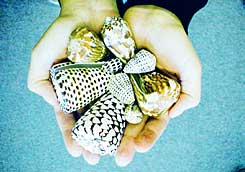Cone snail shells. The medical importance of the venom lies in the fact that it closes channels in the cell membrane with a very high level of precision
Henry Fountain, Haaretz, voila!

Direct link to this page: https://www.hayadan.org.il/Conusmagus.html
For hundreds of years cone snails have been coveted items due to their delicately decorated shells, which are considered valuable by collectors. Recently, the carnivorous snails have become desirable for another reason: in their powerful mixture of poisons, according to researchers, lies the promise of new drugs.
But now other researchers are warning that the high demand for cone snails has serious consequences. In a letter sent to the journal "Science", three scientists claim that collecting the snails for trade in the jewelry market and for medical research, along with the destruction of habitats and climate changes, puts these animals at risk of extinction. Without supervision and control of the trade, the researchers warn, many of the approximately 500 cone snail species will be lost before their value to mankind is known.
"We may lose the animal from which more drugs can be extracted than from any other animal in nature," said Dr. Eric Chivian at Harvard Medical School, one of the authors of the letter.
Cone snails eat other molluscs, worms and fish. They inject venom into their prey through a tooth-like organ, sharp and hollow. This venom is a lethal cocktail, estimated to contain 50 to 100 peptides (short chains of amino acids). Each species of cone snail has a different cocktail, and according to Chivian, that means there may be as many as 50 such peptides, called conotoxins.
The conotoxins, of which only about a hundred have been studied so far, arouse the curiosity of researchers because it was discovered that they bind to unique receptors of ion channels - openings in the cell membrane, which allow the occurrence of chemical changes that can cause disease or disease. "What these toxins do better than anything else is plug the openings with incredible precision," said Dr. Aaron Bernstein, one of the authors of the letter and a visiting researcher at Harvard.
"The selectivity and sensitivity of the conotoxins make them an important medical tool," Bernstein said. According to him, the conotoxins may serve as a basis for new drugs whose binding to unique receptors may prevent side effects. A powerful pain reliever based on a peptide discovered in the Conusmagus cone snail is already in the final stages of clinical trials. But the study of conotoxins requires collecting large quantities of snails from coral reefs, marshes, and other shallow bodies of water in order to obtain sufficient venom samples. Qivian mentioned a research lab at an American university, which he asked not to be named, that imported 10,000 cone snail venom glands from China for one study.
However, according to Dr. Calum Roberts - a biologist specializing in the conservation of marine habitats at the University of York in the UK and the third author of the letter - the commercial collection for the ornament market is apparently a more difficult problem. Millions of shells are collected for commercial purposes and end up in gift shops all over the world, where they are sold for a few dollars each. "The value we attribute to snails as ornaments is much lower than their value to society due to their medicinal uses," said Roberts.
https://www.hayadan.org.il/BuildaGate4/general2/data_card.php?Cat=~~~680649983~~~32&SiteName=hayadan
